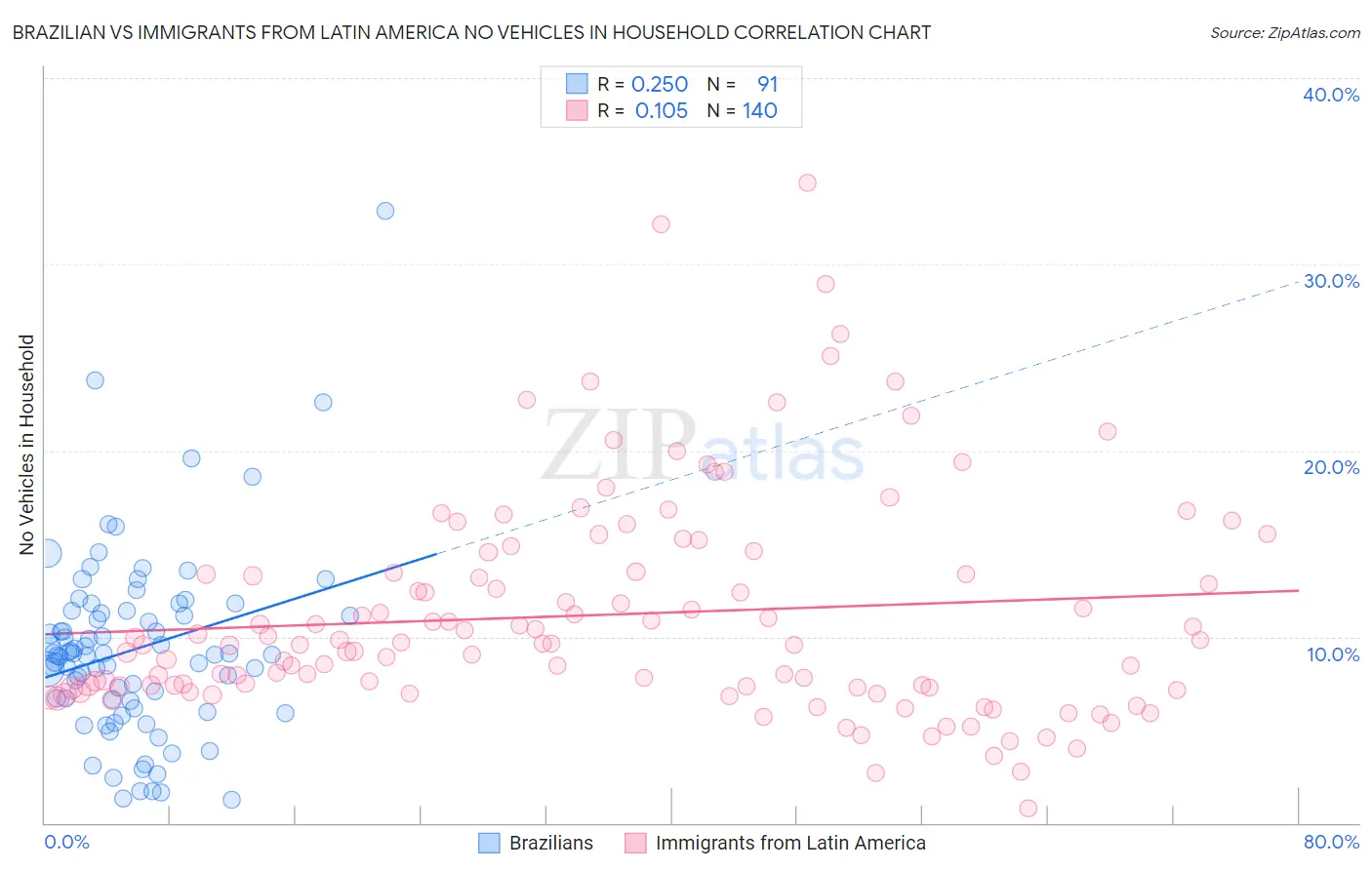Brazilian vs Immigrants from Latin America No Vehicles in Household
COMPARE
Brazilian
Immigrants from Latin America
No Vehicles in Household
No Vehicles in Household Comparison
Brazilians
Immigrants from Latin America
10.4%
NO VEHICLES IN HOUSEHOLD
51.7/ 100
METRIC RATING
172nd/ 347
METRIC RANK
10.4%
NO VEHICLES IN HOUSEHOLD
53.2/ 100
METRIC RATING
170th/ 347
METRIC RANK
Brazilian vs Immigrants from Latin America No Vehicles in Household Correlation Chart
The statistical analysis conducted on geographies consisting of 322,964,874 people shows a weak positive correlation between the proportion of Brazilians and percentage of households with no vehicle available in the United States with a correlation coefficient (R) of 0.250 and weighted average of 10.4%. Similarly, the statistical analysis conducted on geographies consisting of 543,017,545 people shows a poor positive correlation between the proportion of Immigrants from Latin America and percentage of households with no vehicle available in the United States with a correlation coefficient (R) of 0.105 and weighted average of 10.4%, a difference of 0.21%.

No Vehicles in Household Correlation Summary
| Measurement | Brazilian | Immigrants from Latin America |
| Minimum | 1.2% | 0.80% |
| Maximum | 32.9% | 34.4% |
| Range | 31.6% | 33.6% |
| Mean | 9.3% | 11.2% |
| Median | 9.0% | 9.6% |
| Interquartile 25% (IQ1) | 6.6% | 7.2% |
| Interquartile 75% (IQ3) | 11.4% | 13.5% |
| Interquartile Range (IQR) | 4.8% | 6.2% |
| Standard Deviation (Sample) | 5.0% | 5.9% |
| Standard Deviation (Population) | 5.0% | 5.9% |
Demographics Similar to Brazilians and Immigrants from Latin America by No Vehicles in Household
In terms of no vehicles in household, the demographic groups most similar to Brazilians are Hmong (10.4%, a difference of 0.14%), Filipino (10.4%, a difference of 0.22%), Immigrants from Sudan (10.4%, a difference of 0.23%), Immigrants from Burma/Myanmar (10.4%, a difference of 0.34%), and French American Indian (10.4%, a difference of 0.34%). Similarly, the demographic groups most similar to Immigrants from Latin America are Hmong (10.4%, a difference of 0.060%), Lumbee (10.3%, a difference of 0.21%), Filipino (10.4%, a difference of 0.42%), Immigrants from Sudan (10.4%, a difference of 0.43%), and Indonesian (10.3%, a difference of 0.48%).
| Demographics | Rating | Rank | No Vehicles in Household |
| New Zealanders | 65.1 /100 | #161 | Good 10.2% |
| Immigrants | Austria | 64.4 /100 | #162 | Good 10.2% |
| Immigrants | Cambodia | 63.7 /100 | #163 | Good 10.2% |
| South Africans | 61.1 /100 | #164 | Good 10.2% |
| Comanche | 60.8 /100 | #165 | Good 10.2% |
| Immigrants | Costa Rica | 60.5 /100 | #166 | Good 10.3% |
| Immigrants | Saudi Arabia | 58.8 /100 | #167 | Average 10.3% |
| Indonesians | 56.7 /100 | #168 | Average 10.3% |
| Lumbee | 54.7 /100 | #169 | Average 10.3% |
| Immigrants | Latin America | 53.2 /100 | #170 | Average 10.4% |
| Hmong | 52.7 /100 | #171 | Average 10.4% |
| Brazilians | 51.7 /100 | #172 | Average 10.4% |
| Filipinos | 50.1 /100 | #173 | Average 10.4% |
| Immigrants | Sudan | 50.0 /100 | #174 | Average 10.4% |
| Immigrants | Burma/Myanmar | 49.1 /100 | #175 | Average 10.4% |
| French American Indians | 49.1 /100 | #176 | Average 10.4% |
| Immigrants | El Salvador | 49.1 /100 | #177 | Average 10.4% |
| Immigrants | Ethiopia | 48.0 /100 | #178 | Average 10.4% |
| Ethiopians | 45.8 /100 | #179 | Average 10.5% |
| Arabs | 45.3 /100 | #180 | Average 10.5% |
| Immigrants | Colombia | 44.1 /100 | #181 | Average 10.5% |